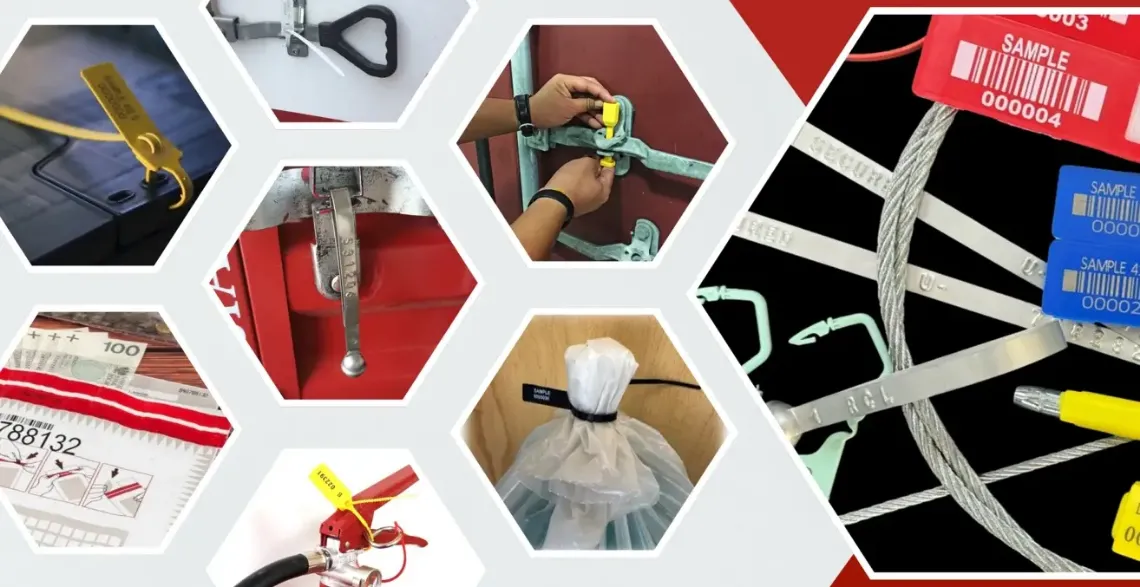Security seals may be small, low-cost components, but in logistics they play an outsized role. They protect high-value goods, maintain the chain of custody, provide tamper evidence, and support regulatory compliance. Yet across transport fleets, fulfilment centres, 3PLs, and healthcare logistics, seal failures are almost always caused by human error rather than product failure.
Below are the five most common mistakes logistics teams make with tamper-evident seals — and how the right practices can dramatically strengthen supply-chain security.
1. Using the Wrong Type of Seal for the Application
One of the most frequent issues is simply choosing the wrong seal. Different seals exist for different levels of risk, strength, and regulatory requirement — but fast-paced operations often default to whatever is immediately available.
Common misapplications include:
- Applying non-ISO 17712 High Security Seals to international export containers
- Specifying lighter weight pull-tight seals where strength is needed, for example on roll-cages
- Using fixed-length seals where adjustable pull-tight seals are required, for example mail sacks
- Applying security labels where a mechanical seal is needed
Why it matters
A mismatch between seal type and application can result in breakage, tampering opportunities, or non-compliance with border requirements.
How to avoid it
Conduct a simple seal audit and choose seals based on application, risk level, and compliance needs. Universeal supplies a full range of pull-tight, fixed-length, cable, bolt and label-based seals to suit every requirement. Use the Security Level, Break Strength and Removal Method filters on our security seals page to find suitable products for your needs.
2. Failing to Record Seal Numbers Correctly
A security seal is only effective when its unique serial number is captured as part of a documented chain of custody. Failure to do this is surprisingly common and undermines the entire purpose of the seal.
Typical recording errors include:
- Seal numbers not logged at dispatch
- Incorrect manual number entry
- Numbers not matched at delivery
- Barcodes available but not scanned
- Receipts or matched stubs misplaced
Why it matters
If the seal number is not recorded, there is no verifiable chain of custody — making it impossible to prove tampering or compliance.
How to avoid it
Consider using barcoded seals, integrate seal number capture into dispatch/receipt system workflows, and train staff to treat seal numbers as critical documentation.
3. Incorrect Seal Application
Even the best seal can fail if installed incorrectly. Poor application creates vulnerabilities and undermines tamper evidence.
Typical application mistakes:
- Seal not fully locked or “half-clicked”
- Pull-tight seals left with excess slack
- Seals fitted to the wrong latch or tie-point
- Security labels poorly adhered or placed on unsuitable surfaces
Why it matters
Incorrectly applied seals can be bypassed, re-seated, or removed without detection, creating significant security risks.
How to avoid it
Create standard operating procedures showing correct threading, locking, placement, and the required number of seals per door or latch.
4. Reusing Single-Use Security Seals
Although seals are designed for single use, attempts to reuse them are more common than expected — typically due to cost-saving attempts or misunderstanding.
Examples include:
- Trying to re-thread a broken pull-tight seal
- Applying tape or adhesive to a broken seal
- Re-sticking tamper-evident labels
Why it matters
Single-use seals are designed for destructive removal. Reusing them eliminates tamper evidence entirely and poses major compliance risks.
How to avoid it
Train staff on proper usage, encourage reporting of broken or missing seals, and use colour-coded batches to prevent accidental reuse. For closed loop logistics and workflows, consider switching to reusable, tamper-evident security bags with locking chambers.
5. Insufficient Staff Training
Seal handling is often skipped in onboarding, yet it is a crucial part of the chain of custody. Without proper training, teams are more likely to misuse or misapply seals.
Common training gaps:
- Not knowing which seal to select
- Incorrect application methods
- Poor number recording practices
- Failure to recognise tampering on arrival
Why it matters
Human error quickly becomes the weak point. Improperly handled seals compromise security, compliance, and auditability.
How to avoid it
Introduce a simple training module covering seal selection, application, number tracking, and tampering response. Universeal can provide visual guides and best-practice materials.
Final Thoughts
Tightening seal management is one of the lowest-cost, highest-impact improvements any logistics operation can make. The right seals, used correctly, with proper number recording and basic staff training, greatly reduce risk and improve your chain of custody.
Universeal supplies a full range of tamper-evident security seals for logistics, healthcare, retail and international transport, including:
- Plastic pull-tight seals
- Fixed-length seals
- Cable and ISO 17712 bolt seals
- Tamper-evident security bags
- Security labels and tapes
- Custom-printed options for branding and traceability
For support choosing the right seal for your operation, contact our team today on [email protected] or +44 (0) 1829 760000.

